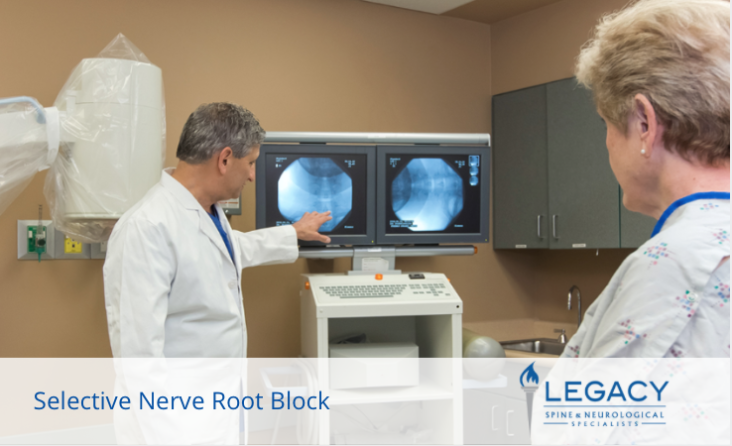What is a Selective Nerve Root Block?
A selective nerve root block (SNRB) is a procedure that helps Legacy surgeons determine the source of your leg or arm pain. There are many nerves in the cervical and lumbar spine. It is sometimes necessary to use more than an MRI, physical exam and symptom evaluation to determine the cause of pain.
A SNRB is one tool to help determine which nerve is causing the problem. Surgeons place a needle on specific nerves and apply an anti-inflammatory with numbing medication. The goal is to see a patient’s response both during the procedure and for 3–24 hours after procedure. It is very important that the patient records a log of their response to the SNRB to see if they have temporary relief of their symptoms. Remember, this is not a treatment and effects will only be temporary.
What can I expect during a Selective Nerve Root Block?
During a SNRB you may choose to use the nitrous oxide to help you relax. You will lie face down on the injection table with your head in a specially designed pillow. The doctor uses x-rays during the procedure to assure proper placement of the needle for your injection.
After determining the best location for your injection with x-rays, the doctor injects a numbing medicine into the skin in the area where you will get the SNRB. Then he or she puts a needle into the numbed area and uses further x-ray images to guide the needle onto the specific nerve the surgeon is interested in. The medication is then injected around the nerve. During the procedure you will be asked if the needle reproduces the pain you usually feel, and if you feel it in the same distribution of your arm and leg that you normally get pain. The discomfort associated with this part will be very temporary. Next, numbing medication and anti-inflammatory is injected onto the nerve.
Your leg or arm may go numb soon after this injection. This will be temporary lasting less than 24 hours but you will be taken out of the procedure room in a wheel chair. It is important to have assistance when using the affected limb. Remember to record if you have relief of your symptoms at anytime during the 24 hours after your injection.
Your surgeon will use this information to determine the next step in your treatment plan.
The procedure takes about 10–15 minutes. Please arrange for someone to drive you home and to have assistance until the medication wears off, usually within 24 hours.
What are the typical results of a Selective Nerve Root Block?
At Legacy, we recognize that no patient is the same, and therefore no result is the same or “typical”. However, if a patient’s pain is relieved after the injection, we can assume that the nerve root that was just injected was the generator of the pain. If that is the case, the patient can feel relief from that anti-inflammatory medication. Your doctor may request physical therapy after the injection or set of injections to help build up core muscles and back strength. Legacy provides an excellent physical therapy program that has helped patients get back to life quickly and stay pain-free.

